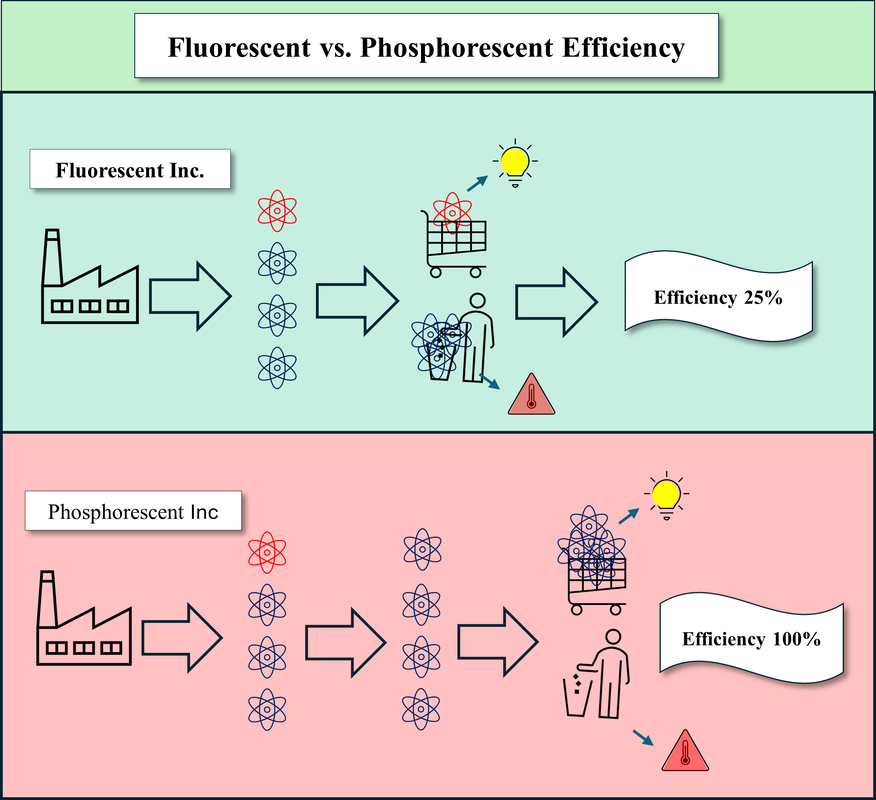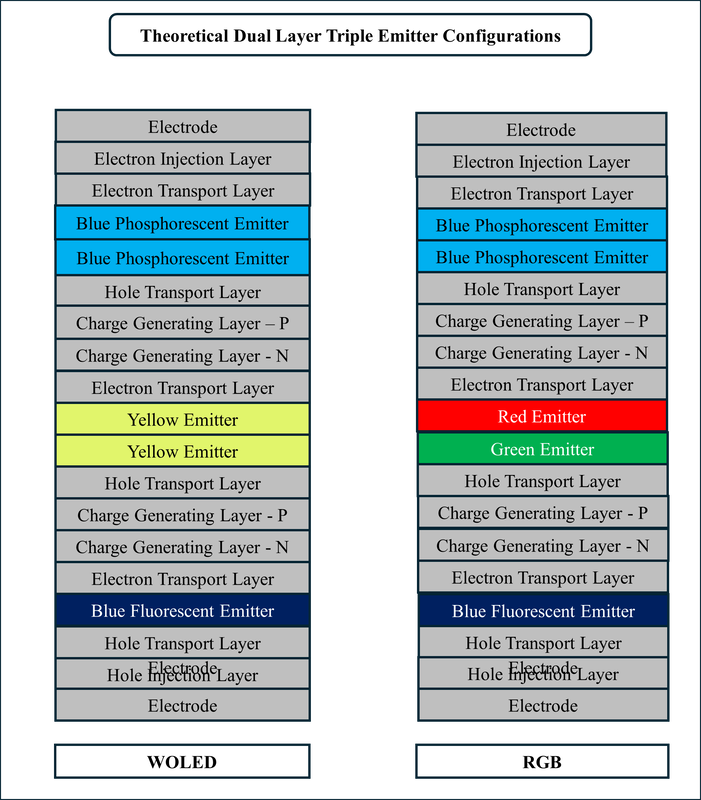Funny, You Don’t Look Bluish


Sooner or later the folks at Fluorescent Inc (Factory a) figured out that they are going to go out of business, having such a low efficiency rating, and the economic impact to Pixeltown would be catastrophic. Management hired a hot-shot banker and put out some feelers but there were no takers until the banker’s lowly assistant figured out that if you were to combine both fluorescent and phosphorescent materials together when making excitons, the result would be even better than the two individually.
Here’s why. If the materials are carefully matched, the ability of Phosphorescent Inc’s process to use both triplet and singlet excitons to produce light, allows some of the triplet excitons that Fluorescent Inc produces but throws away (heat rather than light), to become useful. This means that the combined fluorescent and phosphorescent emitters could have an efficiency that is higher than 25% for the fluorescent excitons and remain at 100% for phosphorescent excitons, essentially improving the efficiency of the combination by about 15%. Not all of the fluorescent triplet excitons can be converted and used by the phosphorescent emitter, but enough to make a difference.

LG Display (LPL) made an announcement today that will undoubtedly shake up things in the OLED space, but the devil is in the details and it is essential to understand how OLEDs work in order to quantify the announcement. In fact the structure that LG Display is speaking about is similar to the tandem system that the company uses for production of small OLED displays for ‘a large customer’. Typically, in order to improve brightness, the dual stack approach is used, essentially squeezing two OLED stacks between electrodes instead of one. This helps, but is an expensive solution as OLED materials, particularly phosphorescent emitters, are costly, especially if you are duplicating the entire (RGB) stack, and increases the number of steps involved in the deposition process, which has a tendancy to reduce yield.
We believe the LG Display approach is both similar in that it uses a multi-stack approach, but it is also a bit different. We expect that the phosphorescent blue host and dopant combination that LGD is using would not stand on its own commercially quite yet, as it could possibly fall short on a particular commercial specification, any of three major categories, lifetime, efficiency, or color point. Developers must balance these three factors when trying to create a stable phosphorescent emitter and that has been a difficult task for all. Materials that have the necessary color point (deep blue) might have a lifetime that is too short to use commercially or be lacking in efficiency (high power usage). Other materials that have a more extended lifetime might not have the necessary color point. You get the idea. So while the concept of using a combination of blue phosphorescent and blue fluorescent emitters has promise, it is an interim solution until a truly stable blue emitter and host combination can be found.
LG Display was careful to call this iteration ‘a step closer’ and not a final solution, but it will certainly get LG Display some acclaim and cachet from the announcement. The response from Samsung Display (pvt) will be interesting to see as they have been working on the same blue phosphorescent emitter with Universal Display (OLED) for years and at one time, years agho, evaluated a combination blue Phosphorescent/Fluorescent combination. We also expect a response from both the TADF community and those developing quantum dot EL displays.
Here's the LG Display Press release: (our highlights in red)
LG Display, the world’s leading innovator of display technologies, announced today that it has become the world’s first company to successfully verify the commercialization-level performance of blue phosphorescent OLED panels on a mass production line. The achievement comes about eight months after the company partnered with UDC to develop blue phosphorescence and is considered a significant step closer to realizing a “dream OLED” display.
In the display industry, “dream OLED” refers to an OLED panel that achieves phosphorescence for all three primary colors of light (red, green, and blue). OLED panel light emission methods are broadly categorized into fluorescence and phosphorescence. Fluorescence is a simpler process in which materials emit light immediately upon receiving electrical energy, but its luminous efficiency is only 25%. In contrast, phosphorescence briefly stores received electrical energy before emitting light. Although it is technically more complex, this method offers luminous efficiency of 100% and uses a quarter as much power as fluorescence.
However, achieving blue phosphorescence has remained a major challenge even more than 20 years after the commercialization of red and green phosphorescence. This is due to blue, among the three primary colors, having the shortest wavelength and demanding the greatest energy.
LG Display has solved this issue by using a hybrid two-stack Tandem OLED structure, with blue fluorescence in the lower stack and blue phosphorescence in the upper stack. By combining the stability of fluorescence with the lower power consumption of phosphorescence, it consumes about 15% less power while maintaining a similar level of stability to existing OLED panels.
In particular, LG Display is the first to succeed in reaching the commercialization stage of blue phosphorescent OLED panels, where performance evaluation, optical characteristics, and processability on actual mass production lines should all be confirmed. The company has already completed commercialization verification with UDC.
LG Display has independently filed patents for its hybrid blue phosphorescent OLED technology in both South Korea and the United States.
The company will showcase a blue phosphorescent OLED panel featuring two-stack Tandem technology at SID Display Week 2025, the world’s largest display event, in San Jose, California from May 11th (local time).
At the show, LG Display will be unveiling a blue phosphorescent OLED panel featuring two-stack Tandem technology applied to a small and medium-sized panel that can be applied to IT devices such as smartphones and tablets. As more and more products require high definition and high efficiency such as AI PCs and AR/VR devices, the application of blue phosphorescence technology is expected to expand rapidly.
“The successful commercialization of blue phosphorescence technology, which has been called the final piece of the ‘dream OLED’ puzzle, will become an innovative milestone towards the next generation of OLED,” said Soo-young Yoon, CTO and Executive Vice President of LG Display. “We expect to secure a leading position in the future display market through blue phosphorescence technology.”
Based on LG Display’s IP here’s what we think the configurations might be…


 RSS Feed
RSS Feed